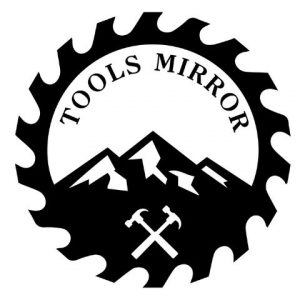In the realm of construction and woodworking, the cordless nail gun stands as a testament to technological innovation. This compact powerhouse has revolutionized the way professionals and DIY enthusiasts approach their projects. But have you ever wondered about the wizardry behind its seamless operation?
In this exploration, we unveil the intricacies of how a cordless nail gun works, shedding light on the mechanical ballet that transforms a simple press of a trigger into precise, effortless fastening.
Join us on this journey through the core principles that power the efficiency of this indispensable tool.
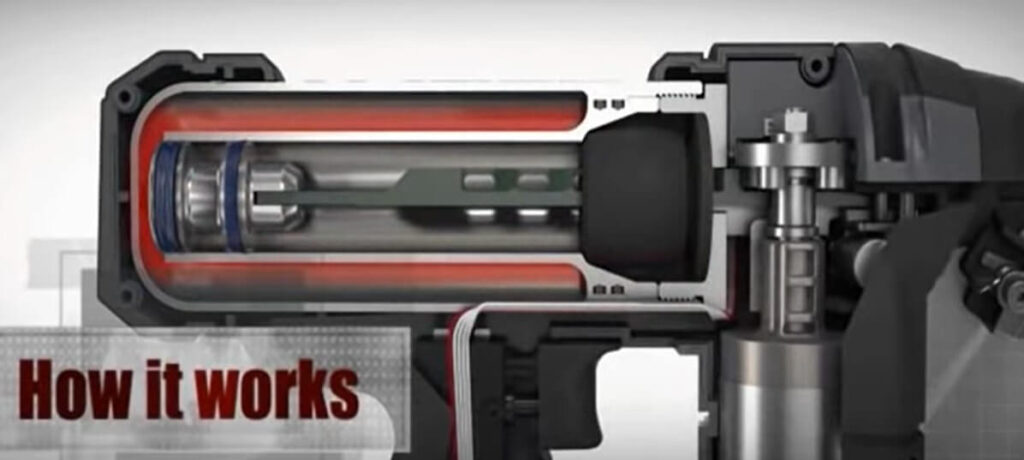
What Is A Cordless Nail Gun?
A cordless nail gun is a portable and battery-powered tool designed for fastening nails into various materials without the need for a traditional power cord or air compressor.
It operates by utilizing stored compressed air or a motor-driven mechanism to drive nails into surfaces, providing convenience and flexibility for construction and woodworking projects.
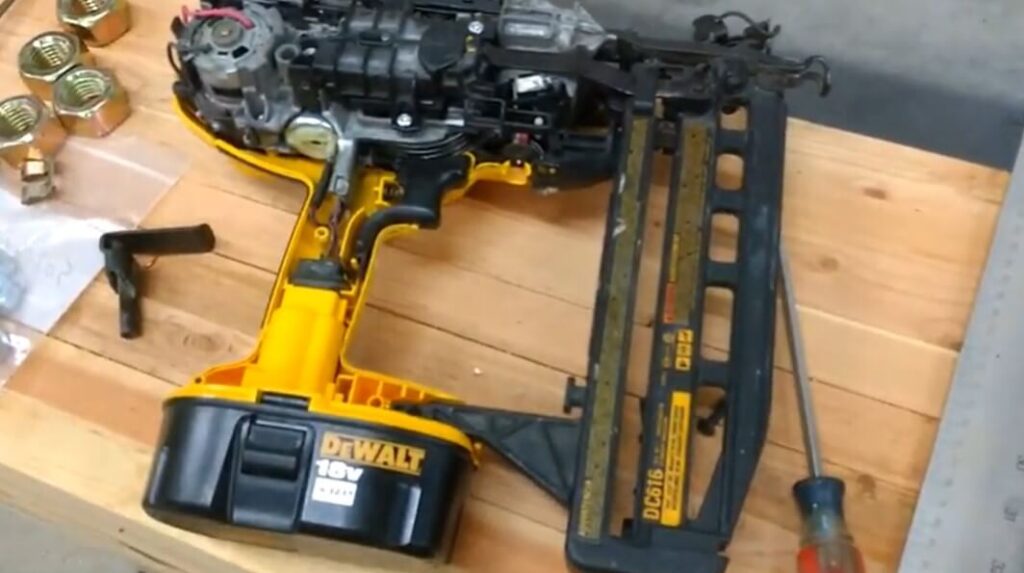
What Are The Uses Of A Cordless Nail Gun?
A cordless nail gun is versatile and widely used in construction and woodworking for tasks such as framing, molding, trim work, and other fastening applications.
Its portability and efficiency make it a convenient tool for professionals and DIY enthusiasts alike, allowing for quick and precise nailing without the constraints of cords or air hoses.
What Do Cordless Nailing Guns Eliminate The Need For?
Cordless nailing guns eliminate the need for traditional power cords and air compressors, providing greater mobility and flexibility in construction and woodworking applications.
How Do Cordless Nail Guns Receive Power?
Cordless nail guns receive power from rechargeable batteries, typically lithium-ion batteries. These batteries provide the necessary energy to drive the internal mechanisms of the nail gun, eliminating the need for external power sources such as cords or air compressors.
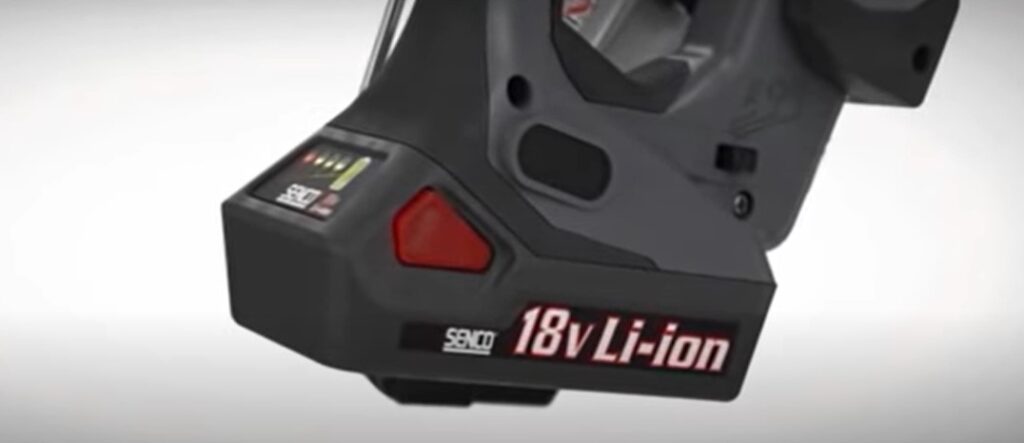
Powering A Cordless Nail Gun And Its Components
Based on the power source there are two main types of cordless nail guns: battery-powered and gas-powered.
Both types have their own unique mechanisms for driving nails, but they share the same basic goal: to convert energy stored in a battery or fuel cartridge into enough force to propel a nail into a material.
Battery-Powered Cordless Nail Guns:
Battery: The heart of the nail gun is a rechargeable lithium-ion battery that provides the electrical energy to power the motor.
Motor: The battery powers an electric motor, which is typically a brushless DC motor for its efficiency and high power output.
Flywheel: The motor drives a flywheel, which is a heavy disc that spins at high speeds when the trigger is pulled. The flywheel stores kinetic energy, similar to how a car’s flywheel stores energy for the engine.
Piston and driver: When the trigger is pulled and the nose of the nail gun is pressed against the workpiece, the stored kinetic energy in the flywheel is transferred to a piston and driver assembly. The piston acts like a hammer, driving the driver forward with great force.
Nail magazine: The driver pushes a nail from a magazine into the workpiece. The magazine holds a strip of nails, which are typically collated, meaning they are stuck together with paper or plastic strips for easy loading.
Safety features: Cordless nail guns have several safety features to prevent accidental firing, such as a trigger lockout and a contact trip switch that requires the nose of the gun to be pressed against the workpiece before it will fire.
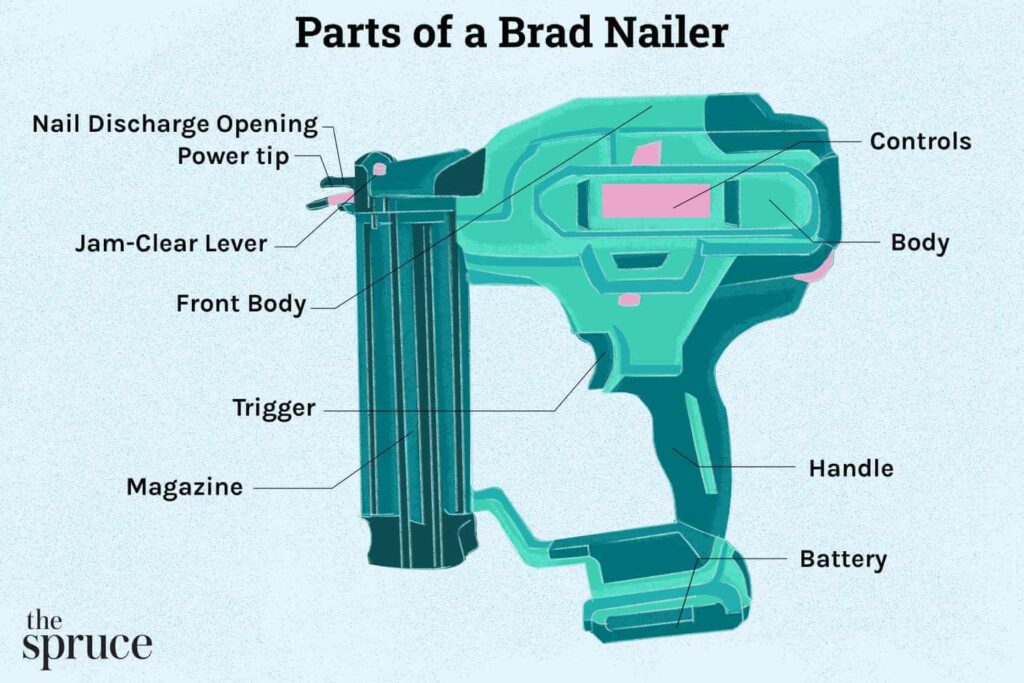
Gas-Powered Cordless Nail Guns:
Fuel cartridge: Gas-powered nail guns use a small, single-use fuel cartridge that contains a flammable gas, such as propane or butane.
Ignition system: The fuel cartridge is connected to a spark plug and ignition system. When the trigger is pulled, a spark ignites the gas in the cartridge, creating a small explosion.
Piston and driver: The explosion forces a piston forward, which drives the driver and nail into the workpiece.
Nail magazine: Similar to battery-powered nail guns, gas-powered guns have a magazine that holds a strip of collated nails.
Safety features: Gas-powered nail guns also have safety features, such as a trigger lockout and a contact trip switch.
Here’s a table summarizing the key differences between battery-powered and gas-powered cordless nail guns:
| Feature | Battery-powered | Gas-powered |
|---|---|---|
| Power source | Rechargeable lithium-ion battery | Single-use fuel cartridge |
| Energy storage | Kinetic energy in flywheel | Potential energy in compressed gas |
| Firing mechanism | Trigger releases stored kinetic energy | Trigger ignites gas, creating an explosion |
| Advantages | Quiet, no fumes, no need for compressor | Powerful, fast firing rate |
| Disadvantages | Limited power, battery needs charging | Relies on fuel cartridges, can be loud |
Ultimately, the best type of cordless nail gun for you will depend on your needs and preferences. If you need a powerful nail gun for heavy-duty work, a gas-powered model may be the better choice.
However, if you prefer a quieter and more convenient option, a battery-powered nail gun is a good choice.
What Are The Different Types Of Batteries?
Different types of batteries can be used in cordless nail guns, each with its unique advantages and disadvantages. Here’s what you need to know:
Lithium-ion (li-ion) batteries are the most common type of battery used in cordless nail guns. They offer a high power-to-weight ratio, long battery life, and quick charging times. They are also unlikely to develop a memory effect, which means they can be recharged at any time.
Nickel-cadmium (nicd) batteries are less common, but they are still used in some cordless nail guns. They are cheaper but bulkier than li-ion batteries and can develop a memory effect. They also have shorter battery life and longer charging times than li-ion batteries but are more robust and can handle rougher working conditions.
Nickel-metal hydride (nimh) batteries are more environmentally friendly than nicd batteries but are not as prevalent in cordless nail guns as li-ion batteries. They have a higher energy density than nicd batteries, meaning they can hold more charge per unit weight. However, they have a shorter lifespan than li-ion batteries.
How The Battery Affects Performance And Runtime?
The battery type used in cordless nail guns directly impacts performance and runtime. Factors that determine battery performance include voltage, amp-hours (ah), and watt-hours (wh).
In general:
- Higher voltage batteries provide more power to the motor and allow the nail gun to work with larger nails or harder materials.
- Higher ah and wh batteries provide longer runtimes, meaning the nail gun can work for extended periods before running out of charge.
- The battery’s age and condition also affect performance and runtime, and they may need replacement after a few years of use.
Cordless nail guns work with batteries that power the motor and drive the piston to push nails into materials. Different types of batteries can be used, each with unique advantages and disadvantages, and the battery type affects performance and runtime.
Choose the right battery according to your needs, and your cordless nail gun will offer you the flexibility, convenience, and freedom of movement that you need to tackle any project effectively.
How The Motor Works To Power The Nail Gun?
The motor is the heart of the cordless nail gun. Its job is to convert electrical energy stored in the battery into mechanical energy to drive the nail.
Here’s a breakdown of how the motor works:
- The trigger initiates the electric current flow from the battery to the motor.
- The electric current spins the motor’s rotor, which is attached to the driver blade.
- As the driver blade rotates, it compresses a spring located behind the blade.
- At the end of the compression cycle, the driver blade snaps forward, driving the nail into the material.
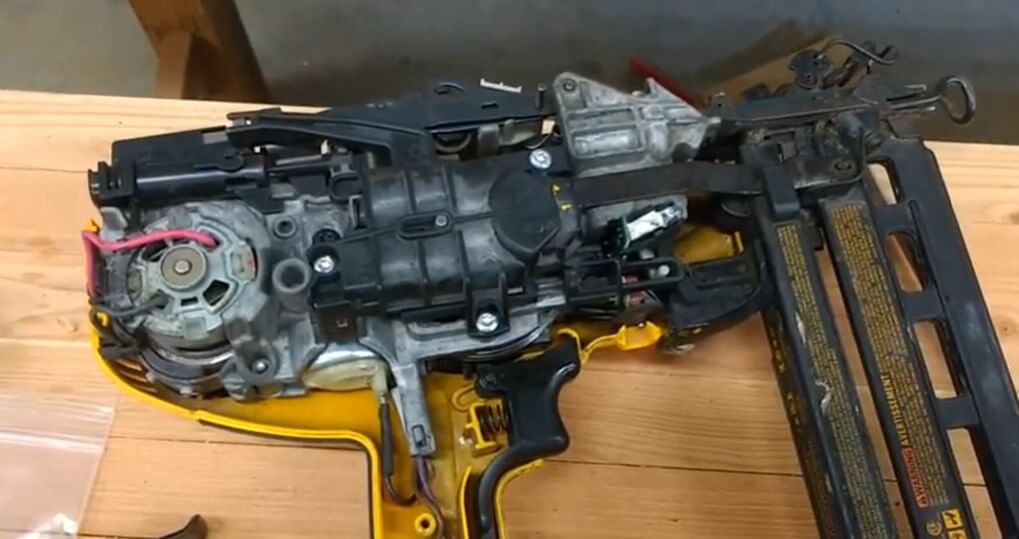
How The Nails Are Driven With A Cordless Nail Gun?
The driving process begins when the trigger is squeezed, and the cordless nail gun releases a burst of compressed air to drive the nail through the workpiece.
Here’s what happens during the nail driving process:
- Squeeze the trigger to activate the cordless nail gun.
- The gun uses compressed air to drive the nail through the workpiece, which is why it’s essential to position the nail gun correctly.
- After you release the trigger, the cordless nail gun resets and is ready for the next shot.
How The Nosepiece Of Cordless Nailer Is Used To Place Nails?
The nosepiece is a small, adjustable component located at the tip of the cordless nail gun. It determines the placement of the nail by guiding it to the correct position on the workpiece.
Here’s how the nosepiece works:
- Select the correct nosepiece for the nail size and shape.
- Position the nail gun where you want to place the nail.
- Align the nosepiece with the spot where you want to drive the nail.
- Squeeze the trigger to drive the nail into the workpiece.
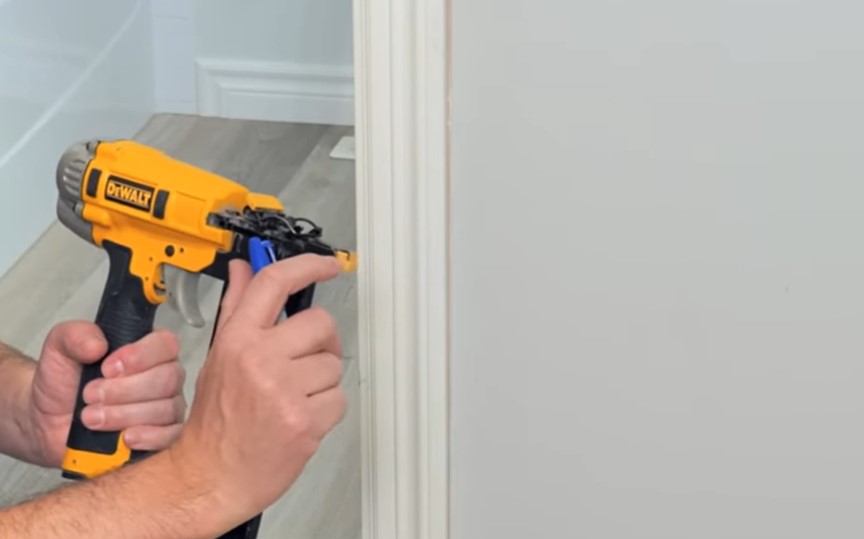
What Is The Method Of Adjusting Nail Depth In A Cordless Nail Gun?
One of the most important functions of cordless nail guns is the ability to adjust the nail’s depth. Adjusting depth is crucial to ensure that the nail heads are flush with the surface of the workpiece.
Here are some essential tips for adjusting nail depth:
- Follow the manufacturer’s instructions for your specific cordless nail gun model.
- Adjust the depth control wheel or knob to change the nail depth.
- Check nail depth before the project to ensure that the nail heads are flush with the surface of the workpiece.
How Does A Cordless Nail Gun Work Animation
How Does The Dewalt Cordless Nail Gun Work?
The Dewalt Cordless Nail Gun operates through a straightforward process:
Loading: Begin by loading the appropriate nails into the magazine of the nail gun.
Power Source: The cordless nail gun relies on a rechargeable battery for power. Ensure the battery is adequately charged and securely attached to the tool.
Activation: Press the trigger to initiate the firing sequence. This action activates the internal mechanisms of the nail gun.
Drive Mechanism: Upon triggering, the nail gun’s drive mechanism, either pneumatic or motor-driven, swiftly moves a piston or driver blade. In pneumatic models, this is powered by compressed air; in electric models, a motor performs this function.
Nail Placement and Firing: The nail is positioned in the gun’s firing chamber, ready to be driven into the material. As the piston or driver blade moves forward, it forcefully propels the nail out of the chamber and into the target surface.
Depth Adjustment: Many cordless nail guns offer depth adjustment features, allowing users to control how deeply the nails are driven into the material.
Repeat: The user can continue to press the trigger for subsequent nail placements, making the process efficient and rapid.
Safety Mechanisms: Cordless nail guns often incorporate safety features, such as anti-dry fire mechanisms, to prevent firing when no nails are present in the chamber.
By following these steps, the Dewalt Cordless Nail Gun simplifies and accelerates the nailing process, offering convenience and precision in various construction and woodworking applications.
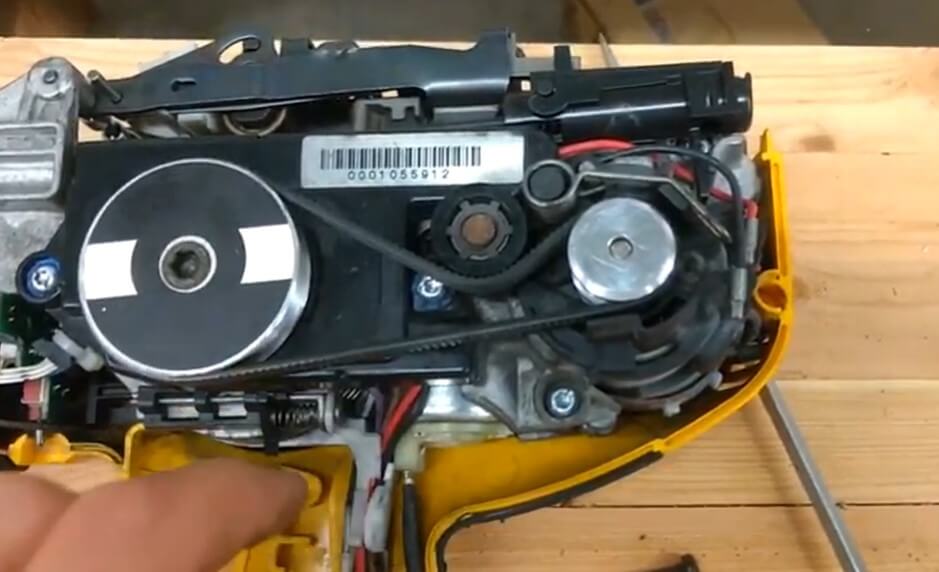
Cordless Nail Gun Maintenance
General Maintenance:
A cordless nail gun is a versatile tool that can make any nailing job quick and effortless. However, like any power tool, it requires regular maintenance to guarantee efficient operation.
The tips listed below will help you keep your cordless nail gun in top-notch condition:
- Check your nail gun’s owner’s manual to see the recommended maintenance schedule
- Inspect the nail gun for damage and excessive wear and tear before each use
- Keep the nail gun clean and well-lubricated
- Store the nail gun properly when not in use
Cleaning And Lubrication
Keeping your cordless nail gun clean and properly lubricated is crucial for hassle-free operation. It will also contribute to the longevity of the tool.
Here’s how to clean and lubricate your cordless nail gun:
- Disconnect the nail gun from the power source or remove the battery
- Use an air compressor to blow out debris and dust from the nail gun
- Use a clean, dry rag to wipe the tool’s exterior surfaces
- Apply a few drops of oil to the nail gun’s moving parts and let it sit for a few minutes
- Wipe off any excess oil with a clean rag
- Reconnect the battery or plug in the nail gun to the power source
Troubleshooting Common Problems
Even with excellent maintenance, cordless nail guns might face some issues over time. Knowing how to tackle these problems is essential to get the most out of your tool. Here are some common issues, along with some tips on how to solve them:
- The nail gun won’t fire: Check if the battery is fully charged, or if the nail gun has run out of gas fuel.
- The nail gun fires inconsistently: Check if the nails are correctly loaded or if the nose is obstructed.
- The nails aren’t driven deep enough: Check if the depth adjustment is correctly set, or if you’re using the right size nails.
- The nail gun jams frequently: Check if the nails you’re using are of good quality and suitable for the tool, or if the feed mechanism needs cleaning.
Proper maintenance of your cordless nail gun can make all the difference in its performance and longevity. Make sure to follow the guidelines mentioned above to keep your tool in excellent working condition.
FAQs: How Does A Cordless Nail Gun Work?
How Does A Cordless Nail Gun Work?
A cordless nail gun is powered by a rechargeable battery, which drives nail using compressed air.
What Types Of Nails Can Be Used With A Cordless Nail Gun?
A cordless nail gun can be used with a variety of nails such as finish nails, brad nails, and hardwood nails.
How Long Does The Battery Of A Cordless Nail Gun Last?
The battery life of a cordless nail gun varies depending on the model and usage. However, most batteries last for a few hours.
What Safety Precautions Should Be Taken While Operating A Cordless Nail Gun?
Wear safety glasses and gloves to avoid injuries. Keep the tool away from people when not in use.
Can A Cordless Nail Gun Be Used For Heavy-Duty Projects?
Yes, cordless nail guns can be used for heavy-duty projects depending on the model and nail type.
Conclusion
A cordless nail gun is an efficient and convenient tool used in the construction and woodworking industry. The tool works by utilizing compressed air, battery power or gas to drive nails into surfaces quickly. The cordless nail gun is a game-changer as it allows for flexibility and ease of use as compared to traditional nail guns.
The tool’s design reduces fatigue, allowing for longer working periods, and its cordless nature eliminates the need for extension cords and generators on the worksite. It is essential for users to consider the type of cordless nail gun that works best for them and to follow the manufacturer’s safety instructions.
By understanding how the cordless nail gun works and its limitations, users can maximize its effectiveness and output on the worksite. With this tool in your arsenal, you can accomplish more tasks in less time, making it a worthy investment for your woodworking and DIY projects.
Recent Posts
Woodworking in 2025 is all about efficiency, precision, and smart technology. Whether you're a beginner or a seasoned craftsman, having the right tools can make all the difference. Here are the top 7...
Ever tried drilling into a piece of wood only to end up with a splintered mess or a wobbly hole? Yeah, it's more common than you think. Wood might seem like an easy material to work with, but...
